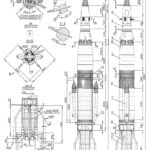On 9 November there was the first battle the MiG-15 carrier-based aircraft of the United States: 18 MiGs 139 GvIAP was found with fifty fighters F9F-2 Panther and F4U-4 Corsair and attack aircraft A-1 Skyraider. The MiGs managed to destroy six planes, and the prize was won by one pilot – commander of the 1st squadron Mikhail Grachev, however, Grachev himself in this battle was shot down and killed.
The first fights with the UN aviation showed that the MiG-15 is much superior to the F-51, F-80 and F9F in almost all settings, except horizontal manoeuvrability.
A deadly adversary of the MiG-15 was for the “Flying fortress” b-29 – the main strike force of the U.S. air force. The air force and the U.S. Navy, formed the basis of aviation United Nations, have lost their unchallenged dominance in the air, which they had almost from the beginning of the Korean war.
Only the emergence in the air “sabres” – F-86 aircraft saved the UN from a complete rout. In the face of the F-86 MiGs got a worthy opponent. In fact, from that moment the outcome of the air battles were decided by the training of pilots and competent management of the air battle from the ground.
The MiG-15 Colonel E. G. Pepelyaev (19 victories) of the 196 th fighter aviation regiment. December 1951
MiG-15 bis of the hero of Soviet Union Lieutenant Colonel V. I. Kolyadina (5 victories) commander of the 28th guards fighter aviation regiment. Spring 1951
MiG-15 bis of captain N. And. Ivanova (8 victories) of the 726 th fighter aviation regiment. July 1953
The participation of Soviet fighter jets in the Korean conflict can be considered quite successful. They fought with the enemy on equal terms, and in the period from April 1951 to February 1952, in its area of responsibility, possessed superiority in the air.
On the Soviet data, during the fighting, pilots of the 64th corps completes 63 229 sorties. Conducted 1683 day air battles and 107 at night. Our pilots shot down 1106 planes. Including 651 F-86, 186 F-84, 121 F-80, 32 F-51, 35 “meteors”, 3-26, 69-29. Their losses amounted to 120 pilots and 335 aircraft.
Fighters of the United Air Army (China and the DPRK), had 366 air battles, which shot down 271 enemy aircraft, including 181 F-86, -84 27 F, 30 F-80, 12 F-51, 7 “meteors”. Their losses amounted to 231 126 aircraft and pilots.
American statistics are sharply different from ours. According to them, the downed 954 Soviet, Chinese and North Korean aircraft, including 827 MiG-15. Official us data give the following figures of the losses. Shot down in aerial combat: 78 F-86, 18 F-84, F 15-Of 80.12 F-51, 17-29.
THE MAIN MODIFICATION OF THE AIRCRAFT
And-310 – the prototype of the MiG-15. Up in the air 30 December 1947, with test pilot V. N. By ganovim. On the plane I felt a big loss of traction. At the suggestion of engineer Kligman shortened nozzle and the fuselage. At the same time made changes to the design of the controls, tail controls and wing. As a consequence, the prototype differed from the production of MiGs. The company has built three prototypes: the C-01, C-02 and C-03.
The MiG-15, serial – the main type of aircraft, produced a large series in variants slightly differing in equipment and armament, and for several years was the main fighter of the Soviet air force and a number of countries. In the first series of the plane had no power steering, automation, engine and brake pads had less space. Since 1949, the aircraft began to enter service with combat units. On serial MiG-15 was conducted experiments on water injection on the inlet to the compressor to increase thrust of the engine, experiments on the use of boosters, as well as start with a mobile catapult. At the speed the aircraft had limitations in at 0.92 M. in addition to the Soviet Union serial production of the MiG-15 was established in Czechoslovakia, Poland and China.
MiG-15P – interceptor, installed in the nose of the fuselage (above the intake) of the radar.
MiG-15C fighter escorts, with the possibility of a suspension discharged fuel tanks with a capacity of 250 l Tanks of metal with a mass of 22 kg or fibre with a mass of 15 kg With the use of external fuel tanks range fighter was increased by more than 400 km.
MiG-15СВ – altitude escort fighter similar to the MiG-15S, but with a modified armament. Cannon NS-23 replaced by HP-23, who had a greater rate of fire and muzzle velocity.
MiG-15UTI (in the entire model documentation was designated the UTI MiG-15) two-seat training fighter. The cabin is divided, equipped with telephone (SPU), the light cover at the front of the cab hinged to the right, the rear – sliding back. Control of lift and with landing gear and flaps-flaps stood in both cabins, but the student is automatically switched off when it is controlled by the instructor. Both cabs are equipped with ejection seats and lights, throw in an emergency situation with the help of squibs. Armament: one machine gun UBK – e (ammunition 150 rounds), sometimes had another gun HP-23 (ammo 80 rounds), individual instances of standing radar (the forward fuselage).
The MiG-15 to fly unmanned were equipped with homing equipment. Purpose – the doodlebug and the maneuvering air target.
MiG-15U (SU), partially movable in a vertical plane rifle installation under the nose of the fuselage. Armament: two cannons NR-30 (ammunition 55 rounds). Subsequently, cannon NR-30 was applied on the MiG-19 and MiG-21 f-13 and also on airplanes Sukhoi.
MiG-15ЛЛ (“Flying laboratory”) – with the increased height of the keel and the amplitude of the stabilizer, at the expense of some reduction of the chord of the tail. The aircraft was used to study the ways of dealing with feedback of roll when turning.
The MiG-15 (SP-1) with the engine VC-1 and radar “Thorium-A” compass ark-5 and MRP-48. Night and all-weather interceptor. Armament – one gun NS-37 (45 shells) and even the NS-45. Intended to be used in air defense. Released in 1949
The MiG-15bis. Had the same size and design as the MiG-15. Work on the design of the MiG-15bis was conducted in accordance with the resolution of Council of Ministers No. 1839-699 may 14, 1949. Engine RD-45F (2270 kgf) was changed to VK-1 (2700 kg). State tests began on 13 September 1949. In addition to the installation of the engine 1, which caused a change in the rear fuselage, the aircraft was equipped with a hydraulic rig-1, to reduce the stresses on the control stick, increased aerodynamic compensation of the Elevator to 22%, the socks of the Elevator and rudder thickened. The forward fuselage also has undergone small changes caused by the installation of guns NR-23. The aircraft also has increased the area of brake flaps to 0.5 m2, and the axis of rotation set at an angle of 22° to the vertical, to reduce pitching moment when you open. In addition, the strength of the aircraft was aligned “with the Norms of strength of aircraft 1947”.
Flight characteristics of the MiG-15
Tests showed that compared to the MiG-15 with RD-45F installing a new engine and a range of improvements has led to a significant improvement in almost all characteristics except range, which has decreased as a result of increasing fuel consumption. The plane was mass-produced and became the most massive modification of the MiG-15.
MiG-15rbis scout with additional photographic equipment. In the lower part of the fuselage mounted camera AFA-and AFA-BA/40.
MiG-15bis (SP-5). Night all-weather fighter with radar “Emerald”. Testing was completed in March 1952. Radar “Emerald” was recognized as the most suitable to be installed on the fighters in terms of reliability and efficiency.
MiG-15bis (MiG-15S)bis – altitude escort fighter with the possibility of a suspension of two PTB capacity of 600 liters.
MiG-15bis 45° (SI-2) – prototype with a redesigned wing sweep of 45°. The aircraft was tested in the second half of 1949 and became the prototype of the MiG-17.
MiG-15bis (ISH) fighter-attack aircraft. Intended for attacks on ground targets. To solve this problem for planes mounted on two beams, which could accommodate bombs and missiles. Testing of the aircraft took place in 1958 – 1964.
N. Food reserve was, A. CHECHIN
Recommend to read
 THE WAY TO “EAST”
THE WAY TO “EAST”
The subject of today's article - geophysical rocket R-2A. In previous publications we described in detail the technology of making copies of R-1 and R-2. The same technology used to... FIRE… WATER
FIRE… WATER
That a few liters of water enough to obtain a flame of high temperature (200° C), make sure everyone, read the description of the device developed by me to the cell. Big flame...
 The history of the MiG-15 began after the Soviet trade representatives in 1946, Britain was able to purchase from the company a Rolls-Royce turbojet engine the most advanced of its time Derwent 5 with a thrust of 1,590 kg, Nene I with a thrust of 2040 kg and Nene II with traction 2270 kg. In the USSR, these engines received the designation RD-500, RD-45 and RD-45F, respectively. After that, it became possible to create a fighter with a flight speed of about 1000 km/h and a ceiling in excess of 13 000 m.
The history of the MiG-15 began after the Soviet trade representatives in 1946, Britain was able to purchase from the company a Rolls-Royce turbojet engine the most advanced of its time Derwent 5 with a thrust of 1,590 kg, Nene I with a thrust of 2040 kg and Nene II with traction 2270 kg. In the USSR, these engines received the designation RD-500, RD-45 and RD-45F, respectively. After that, it became possible to create a fighter with a flight speed of about 1000 km/h and a ceiling in excess of 13 000 m.